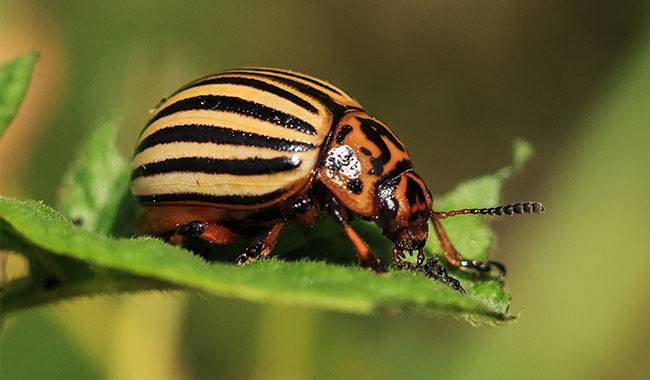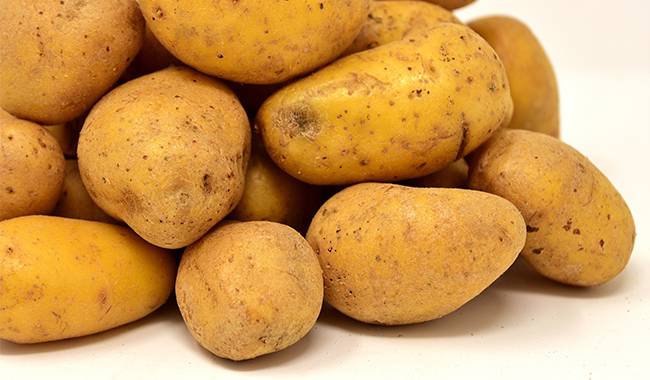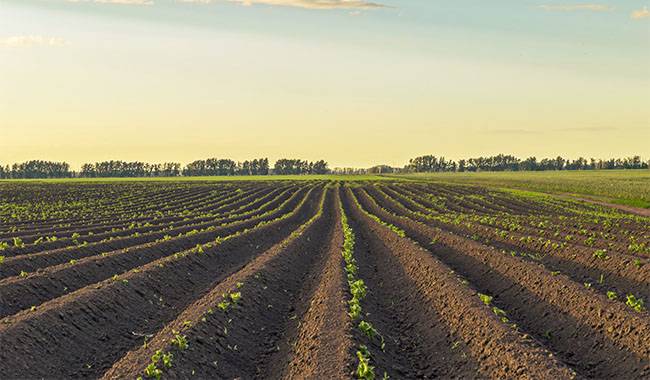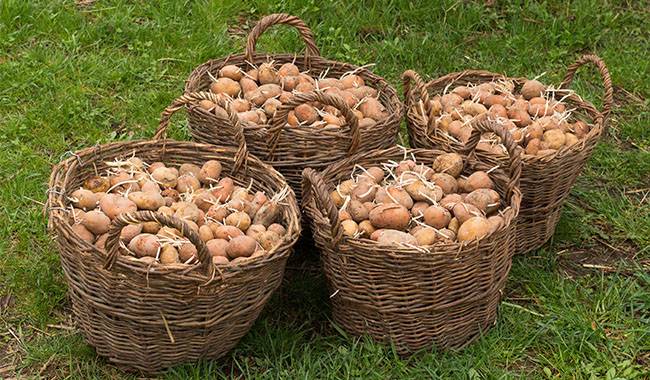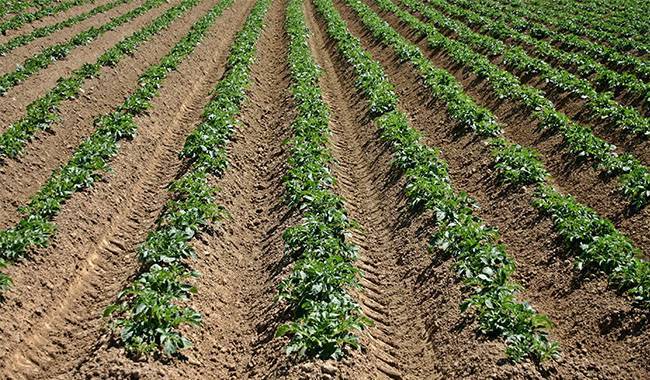
In fact, potatoes are the main vegetable crop in the United States. Chefs can prepare more than 500 dishes without repeating previous ones. In terms of nutritional quality, no vegetable crop can replace the potato in the diet. In addition, potatoes are a technical crop used to produce starch and alcohol. They are the basis for molasses, glucose, glue, vitamin C, rubber, and pharmaceuticals. This article describes how do potatoes grow – planted, grown, cared for, and more.
POTATO HISTORY
Wild potato varieties originated in modern Peru and are found throughout the Americas, from Canada to southern Chile. Although potatoes have been grown in South America for thousands of years, the first potato cubes in North America were not planted in New Hampshire until 1719 (some 80 years later, during the presidency of Thomas Jefferson, when the first French fries were served at the White House).
The potato was originally thought to have been domesticated independently by Native Americans in several locations. Still, later genetic testing of various cultivars and wild species revealed that the potato originated in the southern region of present-day Peru and northwestern Bolivia. The potato was domesticated there about 7,000-10,000 years ago from a species in the Solanum brevicaule complex. In the Andes region of South America, where the species is native, some close relatives of the potato are grown.
In 2007, the United States harvested 19.9 million tons of potatoes, making it the fifth-largest producer. Potatoes are grown in almost every state in the United States. However, about half of the crop comes from Idaho, Washington, Wisconsin, North Dakota, Colorado, Oregon, Maine, Minnesota, California, and Michigan. Most potatoes are harvested in September and October (autumn).
Only about one-third of U.S. potatoes are eaten fresh. About 60% of annual production is processed into frozen products (such as frozen French fries and wedges), chips, dehydrated potato pellets and flakes, and starch, while 6% is reused as seed potatoes. Each American eats more than 121 Lb (55 kg) of potatoes per year. However, consumption of fresh potatoes declined from more than 48 Lb (22 kg) per person in 1993 to less than 35 Lb (16 kg) in 2014.
SOIL PREPARATION FOR POTATOES IN AUTUMN
Potato has excellent properties. It can grow indefinitely and develop high yields in one place for up to 9 years with proper agricultural techniques of soil preparation and cultivation of the crop. In order not to accumulate negative background, it is better to grow potatoes in crop rotation. All squash (zucchini, cucumber, pumpkin), cabbage, beans, peas, and corn are good precursors for potatoes in rotation.
Potatoes do not like acidic soils and prefer neutral soils. Therefore, add wood ash, slaked lime, or dolomite powder (200 g per 11 sq ft) to the soil before planting in spring. Disinfectants can also be used in the fall when preparing the soil.
After harvesting the previous crop in the fall, irrigate aggressively, if necessary, to obtain fall weed emergence. Once weeds have been eliminated, apply a bucket of mature humus or compost every 11 square feet on properly tilled, fertile soil. Phosphate and potash fertilizers were added at 30 and 15 grams per 11 square feet, respectively. The plot was tilled on black, or enzymatically active soil with the tillage layer turned over at 8-10inch (20-25 cm).
Green manure was sown 2-3 weeks later. Preferably, white mustard, sweet clover, oats, and rye are used as green manure. They form considerable biomass in a very short period of time. In the case of early sowing, green manure is incorporated into the soil in autumn; in the case of late sowing, it is left until spring and incorporated by deep loosening the top 4-6inch (10-15 cm) before planting tubers.
On poor soils with insufficient nutrient levels, where the specification of organic and mineral fertilizers has to be increased 2-3 times, green manure must be sown.
POTATO FERTILIZATION
Fertilization in autumn and tending of the plot will provide sufficient nutrients for early potatoes. On Chernozem soils, no additional fertilization is needed (due to the short growing season). On poor and light soils, 30-40 g of ammonium nitro phosphate or nitrogen fertilizer can be applied per 11 sq ft.
When growing medium- and late-maturing varieties with a long growing season, potatoes should be fertilized at the following developmental stages or periods
- Massive germination with light green leaves.
- Emergence.
- Massive flowering.
Feeding in the form of a solution or dry fertilizer under irrigation.
Fertilization at the massive germination stage is best done with nitroglycerin at 30-40 g/11 sq. ft.
Potatoes require potassium, phosphorus, and micronutrients during the bulk germination stage. Fertilizing with potash, phosphorus, and wood ash will accelerate the development of plants at this stage. A mixed foliar spray solution can be prepared. Mix 25 g of potassium sulfate and calcium superphosphate with 0.5 cups of wood ash in 2.5 Gal (10 l) water. Apply a solution of 0.13 Gal (0.5 liters) under the bush, then water and mulch. A cup of wood ash can be used in place of the solution.
During the flowering period, potatoes should be fertilized at a rate of 11 square feet and 30 grams of calcium superphosphate. On poor soils, make a separate mixture of 35-40 g of water-soluble calcium superphosphate with one cup of chicken manure or cowpea mixed with 2.5 Gal (10 liters) of water in a furrow between rows or under a bush. Water the bushes with a watering can without a nozzle at 0.13 Gal (0.5 liters) per bush and soak, or pour 0.25 Gal (1 liter) of the solution in a furrow every 20inch (0.5 meters) between the bushes, then cover with soil, water and mulch.
New forms of fertilizers, such as humic acid and urea can be used for potato fertilization. Application rates, methods, and application times can be found on the package or in the accompanying directions for use. They are applied in loose or heaving conditions. In dry weather, they can be applied with watering and then mulched. All kinds of fertilizer applications should be done in July or one month before potato harvest.
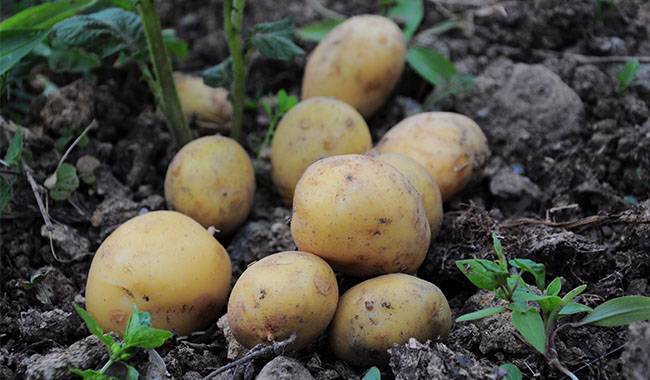
WATERING POTATOES
In dry areas, potatoes should be watered 3-4 times a month. In areas with adequate rainfall, water 1 to 3 times per growing season, depending on the group (early, mid and late). Untimely irrigation can greatly reduce yields. The tubers are very small, hard fleshed, and unpalatable. Determining when to water is simple.
If the lower leaves of the shrub have begun to wilt, you need to water.
Dip the palm of your hand into the soil near the shrub. If half of the soil in your palm is dry, water immediately. The amount of watering should be at least 1.3-1.6 Gal (5-6 liters) per bush if the soil becomes dry, water directly under the bush without pressure to avoid soil erosion. Potato plantations are usually watered in furrows between rows.
POTATO DISEASES
The most common potato diseases are fungal and bacterial: Phytophthora, Rhizoctonia, Rhizoctonia maculosa, and black tibia.
Common control measures are the pre-sowing treatment of tubers with tank mixtures, including bio fungicides.
During the growing season, bushes should be treated with the above-mentioned biocides, but also with Bordeaux mixture or copper sulfate solution as recommended. Biological preparations can be applied to start at the potato germination stage and sprayed every 10-12 days during the summer until harvest time.
Treat bushes with copper-containing preparations, starting at the bush growth and single sprouting stage, once a month. The last treatment was applied 2-3 weeks after cutting the tracts before harvest. Areas of diseased plants (after removal) should be pulverized with a mixture of wood ash and copper sulfate in the ratio of one teaspoon of the preparation per cup of wood ash.
It is beneficial to treat the soil and potato bushes (and, more effectively, seedlings) several times before weeding with wood ash in the summer. Soil can also be treated with chalk powder.
Non-parasitic diseases associated with improper maintenance (fertilization, irrigation) or climatic conditions (prolonged rainfall, low temperatures, humidity) often occur in potatoes. They do not accumulate in the soil or plants and do not spread to healthy crops. As the weather changes to more favorable conditions and farming practices are optimized, the diseases will disappear.
POTATO PESTS
The most dangerous pests of potatoes are Colorado potato beetle, Colorado potato beetle, wireworm, nematode. Effective chemicals developed for each pest are applied in 1-3 treatments during the summer to kill the pest and its larvae: sonnet, confidor, spark, decis, basudin (soil preparation). But it is better to grow potatoes at home without using chemicals.
There are good biological preparations that can kill pests while being harmless to humans and pets. Biological agents have a wide range of effects on pests. Good results can be obtained with Bitoxybacillin and other biological agents. Biological agents for pest control can be prepared in tank mixtures, thus reducing plant treatments.
PROTECTING POTATOES FROM PESTS AND DISEASES
A disease is easier to prevent than to treat. Therefore, to produce healthy potato tubers, preventive measures must be taken every year to reduce or eliminate the causes of the disease.
- breed only varieties that are resistant to the disease
- Grow vegetable crops, including potatoes, in crop rotation.
- disinfect the soil annually if potatoes are grown in the same place for several years.
- Remove diseased shrubs from the field immediately and destroy them.
- Dispose of diseased haulms and do not use them for composting.
- Avoid cutting tubers before planting if possible.
- Do not apply manure to potatoes. Use mature humus, compost, and biomethane when applying potatoes in autumn.
HARVEST POTATOES
Timely fertilization, maintaining optimal soil moisture, loosening and starting the soil, and protecting potatoes from pests and diseases will help obtain a good taste for high yields. Several factors determine the timing of harvesting.
- yellowing and wilting of stalks on medium- and late-maturing potato varieties.
- In the case of early-maturing varieties, it is mainly the calendar harvest date specified in the variety recommendation. Harvesting of early-maturing potato varieties sometimes starts when the stalks are green.
Prune the potato leaves 6-10 days before harvest. This promotes the formation of thicker skins on the tubers and facilitates their maturation. Harvesting is done in dry weather, but in case of heavy rain, potatoes should be dug up and spread out to dry immediately. Moist potatoes are highly susceptible to fungal rot. Late varieties intended for long-term storage should not be delayed in the harvesting process.
Low temperatures can greatly reduce quality. Soil temperatures dropping to 37°F (3°C) will result in up to 80% tuber mortality if not harvested promptly. After harvest, remove potato tracts from the field and destroy them if the potato planting was diseased during the summer. If the tracts are healthy, they should be placed in a compost pit. Remove all potatoes (small, diseased ones) from the field and select healthy tubers as they dry. The diseased ones are discarded.
More Related Information About Planting & Growing Potatoes Plants




